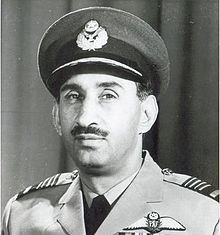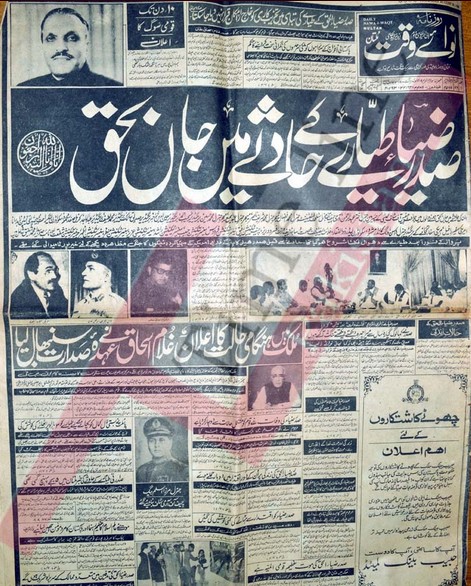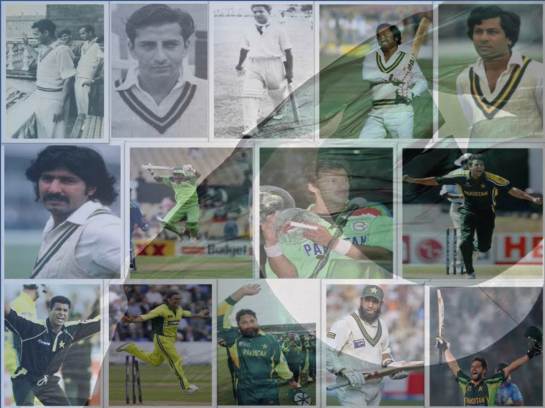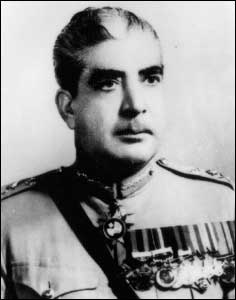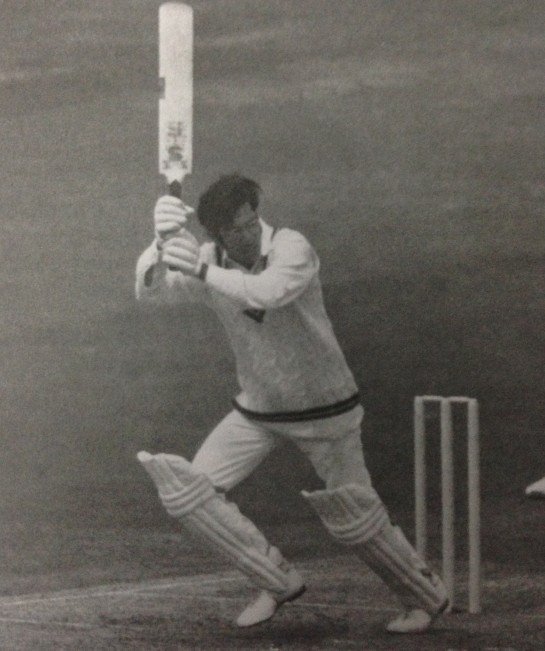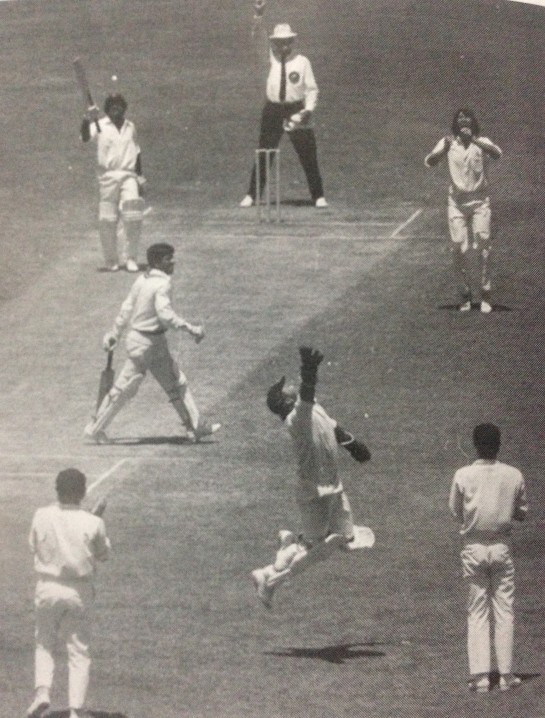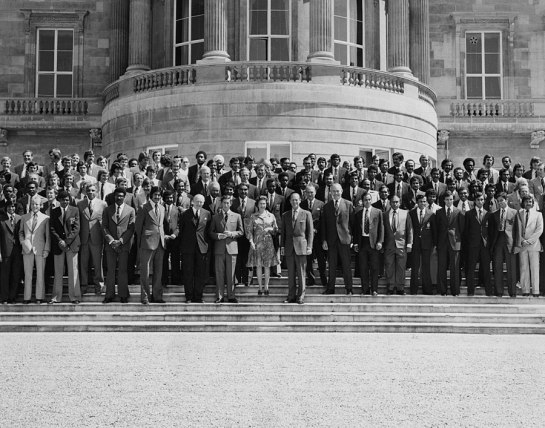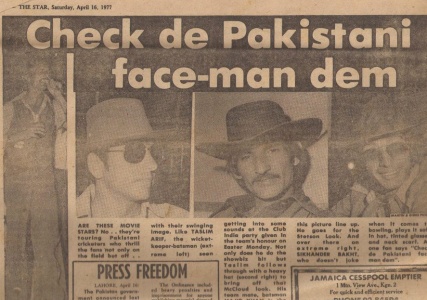Pakistan as a country has been through a number of highs and lows since traumatic partition in 1947 and its cricket has followed the similar pattern, showing how this sport is embedded in social, political and cultural facets of the country. Initially dispersed, unrecognised, underfunded and weak, Pakistan’s cricket team grew to become a major force in world cricket. If cricket is known for its glorious uncertainties, Pakistan team is even more renowned for its unpredictability. In this series of blogs we shall dig into social, political, cultural and sporting history of cricket in Pakistan.
Read previous parts here:
Part I – 1940s: Partition and Founding Stones of Cricket in Pakistan (1947 – 1950)
Part II – 1950s: Pakistan announces itself to cricket world (1951 – 1960)
Part III – 1960s: The Lost Decade (1961 – 1970)
Part IV – 1970s: Revival of Pakistan cricket (1971 – 1980)
Part V – 1980s: The Asian Cricket Tigers Take on the World [1981 – 1990]
In a low scoring series against West Indies (WI) Miandad had batted better than most along with Wasim Raja. However he faced acute hostility from senior players, especially his vice-captain Zaheer Abbas. Nevertheless he led Pakistan to tour of Australia in 1981-82.
Revolt against Miandad and start of Imran’s era
Pakistan played 3 tests during the tour and lost series 2-1. However, Pakistan showed great fight in third test in which 6 batsmen made fifties in first innings. Imran bowled fierce spells of bowling and Pakistan won by an innings and 82 runs. Pakistan could manage to win only 4 out of 10 round matches in Benson & Hedges ODI World Series Cup. However, the highlight of the tournament was infamous confrontation between Miandad and Denis Lillee during the first test. Lillee was fined and banned for two ODIs later. Javed remarks were: “We were after all only Pakistan and he felt he could take liberties with us.”
Sri Lanka toured Pakistan in 1981 – 82 and almost 10 senior players refused to play under Miandad’s captaincy. Miandad voluntarily stepped down after second test match. Imran was made captain which bitterly disappointed Zaheer Abbas again. Pakistan won 3-Test and 3-ODI match series 2-0 and 2-1 respectively.
It was a time for revolution in world cricket. One Day (ODI) cricket was gaining popularity day by day though Test cricket was still regarded as foremost and serious cricket. For Pakistan it was start of Imran’s era.
Imran Khan takes over
Imran Khan has been described as an authoritarian. It is true that he demanded and got his own team and selection committees all but became redundant. But he got results and no one could have accused him of being anything but fair minded. He believed in winning and was not afraid to lose. He wanted what he considered the best team. He even sacked Majid Khan, his cousin, from the team believing that the majestic batsman was past his prime. He took the Pakistan team to England in 1982, lost the series 2-1, but not without a tremendous fight that saw Pakistan win the test match at Lord’s in which Mohsin Khan scored a double century and Imran himself showed his development as an all-rounder. The lesson had been learnt. Pakistan was not to lose another test series against England, either in England or at home. Imran set about restructuring the Pakistan team. He was not afraid of raw and inexperienced youngsters and throwing them in the deep end. He believed in ‘on the job training’.

Imran Khan took 7 for 52, England v Pakistan, 1st Test, Edgbaston, 1st day, July 29, 1982. (Source: ESPN Cricinfo)
Mohsin Khan’s 200 vs England at Lords in 1982
The balance of power was tilting. Pakistan cricketers were no longer patronised by dominant white cricketing nations rather they came to be feared and resented. Pakistan provided cricket the flavour which Brazil provided to football. Two discoveries under Imran’s period stand out: swing blowing, reverse swing in particular, and emergence of wrist blowing in form of Abdul Qadir, an artist with the ball.
In 1982-83 Kim Hughes brought the Australians and they were thrashed 3-0 and then came India with Sunil Gavaskar as captain. It was Imran’s first real test and he came off with flying colours. Pakistan decimated India, winning the series three-nil. However, by now Imran was experiencing recurring pain in his left shin.
Cricket World Cup 1983
Three months after tour of India the x-rays revealed a huge crack on the shinbone of Imran. He needed a period of rest and recuperation. But selectors insisted on keeping him in the team and he was to play as batsman only in World Cup 1983.
Pakistan stumbled through the qualifying round. Near the end of the group matches Pakistan needed to beat New Zealand with a good run rate in order to qualify for semi-final. A masterful century by Zaheer and Imran’s 79 not out brought Pakistan on 261. New Zealand gave a tough competition to Pakistan, With help of good deep fielding Pakistan defeated New Zealand by just 11 runs, edging it out on run rate by only 0.08 runs per over.
The victory took Pakistan to a semi-final against their regular nemesis, WI. Pakistan set a target of 185 only which WI strolled to for loss of just 2 wickets. Imran drew fierce criticism back in Pakistan, especially when India won the World Cup with just putting on 183 runs.
However, this world cup had a moment left till the end which would turn out to be one of the historic ones for Pakistan. It was lunch time the day after India’s victory at Lord’s in 1983 when the President of BCCI, NKP Salve was seething over the rejection of this request for four tickets for his party. Salve speculated what would have happened if the final had been held in India. Nur Khan, the counterpart of BCCP picked up the cue instantly: ‘Why can’t we play the next World Cup in our countries?’ The two men put tireless efforts later on to bring the World Cup to Indo-Pak sub-continent.
The darkest hour for Imran and emergence of Wasim Akram
Imran skipped Pakistan’s tour of India in 1983-84 and Zaheer captained the team and did well enough to draw all the tests. Imran was back to take Pakistan to Australia but did not play in the first three test matches, still nursing his stress-fractured shin but he played in the last two test matches as a batsman and came close to scoring a century at Melbourne. The captaincy alternated between Zaheer and Miandad.
Pakistan achieved its first ever series win against England when England toured Pakistan in 1983-84. India toured in October 1984 which proved to be dull series and was called off mid-way due to assassination of Indira Gandhi. New Zealand (NZ) team followed and Pakistan won the test series 2-0. The series was marred by controversies as NZ consistently complained about questionable decisions of Pakistani Umpires.

Ian Botham wonders how to put all his luggage into the car before departing on England’s tour of Fiji, New Zealand and Pakistan, December 28, 1983
Pakistan had a return trip to New Zealand only weeks later, Javed replaced Zaheer as captain and his first move was to insist inclusion of Wasim Akram in touring party, who was performing well in domestic circuit. The third test produced the first great performance by Wasim, only his 2nd match, taking 5 wickets in each innings. However, match ended in heartbreak for him. Pakistan was without Qadir in this match who had a row with Zaheer and was sent home. He muttered threats of retirement but some of his great days were still ahead.
Imran remained under treatment in England during this whole period. He feared his career was over as the proposed treatment was a new invention and very expensive.
The return of Khan and the most famous shot in the history of the cricket
After expensive and lengthy treatment Imran returned to the national team in tournament to celebrate the 150th anniversary of the Victoria Cricket Association, where he partnered Wasim Akram for the first time. This began the second great blowing partnership of Imran’s career.
Meanwhile, one-day internationals had become a regular feature of cricket and when cricket came to the desert in Sharjah U. A. E., Pakistan and India met regularly before highly partisan expatriate crowds. Zaheer had retired. Imran Khan was the captain again.
It is said that the game of cricket is never over till the end and it truly has provided some great thrills but not more than Miandad’s last ball six against India that won Pakistan the match and drove the Pakistani fans into euphoria. It was the final of Austral-Asia Cup in 1986 at Sharjah. It is possibly the best remembered six in cricket history and the most rewarding one financially for Miandad.
The most important and exhilarating year of Pakistan’s cricket
Pakistan now faced what would become the most elated year in the nation’s cricket history. Imran was about to embark on a cricketing journey that would make or break his reputation as a player and as a captain.
Mighty WI toured Pakistan in 1986-87. The test series ended in 1-1 draw and Pakistan lost the ODI series 4-1. The stand out moment of this series was when very talented Salim Malik came out to bat with broken arm in 2nd innings of first test match at Faislabad. With plaster on his left arm, Malik batted only with right arm and hung on for a 32 run last wicket partnership with Wasim Akram who made an important half century and allowed Pakistan to win the match.
Cricket’s first decisive step towards putting an end to the age-old accusations that had marred home umpiring came on November 7, 1986, when Indian umpires VK Ramaswamy and Piloo Reporter stood in second Test against WI in Lahore. The move was plotted by Imran, who was sick of the criticism after every series in Pakistan. A few years later ICC realised that that’s the way forward when neutral umpires started officiating the matches.
India did not return the compliment of neutral umpires when Pakistan toured India in 1986-87, lasting 2 months in blistering hot weather. This was a difficult series because of the renewed border tensions between the two countries, leading to occasional crowd troubles, in which Pakistan boundary fielders were hit by stones and fruit. In the 4th test they took to wearing helmets in the deep to protect themselves.
Pakistan took the ODI series 5-1. India’s one win came fortuitously from Abdul Qadir, who ran himself out when the scores were level off the last ball. In the excitement, he had forgotten the rules. Pakistan would have won if he had kept his wicket intact.
The first four tests conformed to the recent pattern and were high scoring draws. The fifth and deciding test match at Bangalore, in which India chased 221 for a 4th innings victory, was one of the greatest in history. Worried by vanishing crowds, the authorities left the pitch underprepared to produce some kind of result. As a consequence, Pakistan’s selectors made a crucial last minute decision, with Iqbal Qasim coming in for Abdul Qadir. After many seesaw moments Pakistan eventually set a target of 221 runs to win for India on now a spiteful pitch. They almost got there as Gavaskar gave a masterclass in footwork and timing against the Pakistan spinners. He had reached 96 when Iqbal produced a ball which bounced violently and had him caught at slip. Withstanding a late desperate charge from Roger Binny, Pakistan won a gripping match by 16 runs. It was only Pakistan’s third overseas series win, and on return the team received extravagant public congratulations and welcome with crowd that stretched from airport to the heart of Lahore city.
The team then went to England and there was noticeable tension between the teams, and the English media were nastier than usual. Arriving at Heathrow the team was humiliatingly held up and made to stand aside, with other passengers looking on, while sniffer dogs went through their luggage. It was obvious that it was not going to be an easy tour.
Pakistan lost the ODI Texaco Trophy narrowly, by 2 matches to 1, inspite of a century and two fifties from Miandad. The first two tests were drawn mainly because of rain but the sun was shining at Headingly and England won the toss and decided to bat on a wicket that had pace and bounce and a great deal of seam movement. Imran struck immediately and by lunch Pakistan had seized control of the match. It was a control they were not going to let go off. Pakistan bowled out England for 134 and at one stage for 31 for 5. The Pakistani fast bowlers, Imran, Wasim, and Mohsin Kamal were on a rampage, getting three wickets each. Pakistan went on to make 353 with help of Salim Mailik’s 99. It was a commanding lead and Imran was in his element as he ripped through England taking 7 wickets for 40. Pakistan won by an innings and 18 runs. England had been outplayed.

Wasim Akram bowls, England v Pakistan, 1st Test, Old Trafford, 3rd day, June 6, 1987 (Source: ESPN Cricinfo)
In the final test at The Oval, Pakistan batted for two and a half days, making 708 with Miandad scoring 260 and Salim Malik 102, while Imran helped himself to a blistering 118. It was a mammoth total and England folded up, this time to spin and were bowled out for 240. Qadir, the leg spinner, the magician and the world’s best taking seven for 96. England followed on but helped by some dour batting and a few dropped catches were able to hold out for draw.
This was the first Pakistan team to overcome England in England. Imran was now at his Zenith, indisputably the world’s best all-rounder. Everyone expected him to lead the team to victory in the forthcoming World Cup – the first to be held on home soil.
Cricket World Cup 1987
Before a ball was bowled, the 1987 World Cup was a massive victory for Pakistan. In alliance with India they wrested the competition from English hands and shifted it to the Indian subcontinent. Both countries had to over-come deep seated prejudice about their ability to finance and organise a major international tournament. Nur Khan and Salve worked successfully on their respective governments to release foreign exchange for the World Cup project and invest in infrastructure. Reliance Industries of India put up Rs 70 million which enabled BCCP & BCCI to promise 50% more prize money that their English rivals. Another major objection by England of early twilight in Indian sub-continent was put to rest by reducing ODI to 50 overs a side than 60. The Indo-Pak bid won by 16 votes to 12. The fourth World Cup was more widely watched, more closely fought and more colourful than any of its three predecessors held in England. Significantly, it used neutral umpires.
In Pakistan expectations were immense. Led by Imran, they had their best-ever ODI side to-date. Pakistan played all their group matches at home, gaining five victories out of six. Amid overpowering national expectations, Pakistan took on Australia in the semi-final at Lahore. Australia batted solidly, until Imran’s second spell produced 3 for 17. Steve Waugh took 18 of the last over of the innings bowled by inexperienced left-arm seamer, Saleem Jaffer, which turned out to be difference in the end. Pakistan once again succumbed to the pressure of a semi-final. Chasing 267, Miandad and Imran resurrected the innings after an early collapse, but once the former was out it was a matter of time before the innings folded. Craig McDermott took the maiden 5-wicket haul of the tournament at Lahore to kill a nation’s dream and Pakistan lost the match by 18 runs. Public was utterly disappointed. Immediately after the tournament Sarfraz Nawaz, now a member of parliament, laid charges that match had been thrown to facilitate a betting coup. Players took him to court but action eventually died due to delay of judicial system. It set a pattern for the future, in which Pakistan defeats were assumed to be the result of match-fixing.
It was not perfect moment but Imran nevertheless chose to retire from cricket. The death of his mother Shaukat, from cancer in 1985, had had a profound effect on him and there already intimations that his life was to involve more than cricket. As was now customary, Miandad became captain.
The Shakoor Rana incident – the history repeats itself
The Pakistan-India cricket series are always fuelled with passion and drama, However, ironically there is another rivalry in cricket which has produced more drama and controversies both on and off the field i.e. Pakistan vs England. It all started from the abduction of umpire Idrees Baig in 1955-56 and during England’s tour of Pakistan in 1987-88, the history repeated itself.
England stayed behind to tour Pakistan, a tour whose memory will live in infamy. Even before it began, the tour looked like a mistake. It attracted little interest from Pakistani fans, coming so soon after the disappointment of the World Cup. Still smarting from the series lost in England, it was apparent that there was no love lost between the two teams.
Pakistan won the first test match at Lahore amidst mutterings from the English about poor umpiring. but it was during the second test match at Faisalabad that the tension boiled over. In what came to be known as the Shakoor Rana-Mike Gatting slanging match, there was a hot exchange and much finger-wagging between the umpire and the England captain. Play was suspended the next day because of prolonged parleys centred on the demand by umpire Rana for an unconditional apology from Gatting. The visiting media had a field day as they tried to dowse the fire with petrol! The apology was finally given and play was resumed and the tour continued.
http://tune.pk/video/3141413/cricket-fight-mike-gatting-vs-pakistan-umpire-shakoor-rana
England would not play another Test series against Pakistan for five years, and would not visit the country again for thirteen years. The morally troubled England team faced a dismal future in the wake of Shakoor Rana affair. Pakistan, on the other hand, were going from strength to strength, and greatness lay ahead.
Come back of Imran, whingeing Aussies and the tumultuous political arena
Pressure was mounting on Imran to comeback. BCCP formally asked him, he declined. A series was looming against the West Indies and General Zia uttered a personal plea. Eventually Imran was unable to resist. He realised that his campaign for a cancer hospital in Lahore would be better served if he continued in international cricket. Miandad resigned, once again showing extraordinary grace, self-knowledge and understanding.
The home record of WI in the 1980s was awe-inspiring. In 1987-88, Pakistan arrived to play a team that had not lost a series in 15 years, or a Test in ten. A whole generation had grown up not knowing what defeat meant. The Pakistanis were up against habit as much as anything else. Yet they were the most fancied to turn the tide. Imran’s return began dreadfully as the WI whitewashed Pakistan 5-0 in the ODI series.
Team’s morale was low before the first test in Georgetown but Imran produced outstanding spell of bowling of 7 for 80 resulting WI all out for 292. Pakistan were 57-2 when Miandad arrived and faced a barrage of bouncers and bad language, the stimulus he needed to raise his game. He made a gritting century and was supported by Salim Yousuf (62), Shoaib Muhammad (46) and then the record score of 71 extras. Pakistan got lead of 143. In the end Pakistan needed only 30 in second winnings and won the match by 9 wickets. It was the WI’s first home defeat for a decade. The three match series ended in 1-1 draw. Players who took part in that series still relish it memories and consider it one of the best played series.
Perhaps the most ill-timed tour in Pakistan’s cricket history, by Australia in September and October 1988 was also one of the more unfortunate exercises in cricketing diplomacy. For the second consecutive series in Pakistan, the visiting team was virulent in its criticism of the pitch and the standard of the umpiring during the first Test match of a series. As they had against England the previous year, Pakistan won by an innings, with 17 Australian wickets falling to their spin bowlers. The remaining two Tests were then drawn and the series won 1-0.
However, there were other factors contributing to the tour’s failure to excite more than controversy. The death in a plane crash of General Zia ul-Haq, the President of Pakistan, in August had unsettled the country, with fears of rioting and civil war being expressed. Furthermore, the political parties were preparing for the general election in mid-November. Karachi and Hyderabad were in the grip of ethnic violence, which resulted in the cancellation of the two one-day internationals scheduled for those cities on October 14 and 15 respectively, while the first international of the intended three-match series, at Gujranwala on September 30, had to be called off because floods affected a vast area of the Punjab and Sindh. In their place, an ODI was played at Lahore after the Test match there.
Benazir Bhutto’s PPP won the largest no, of seats, 94, in the National Assembly elections in November and became first woman to rule Pakistan, or indeed any Muslim state. In the provincial elections, the Muslim League under Nawaz Sharif and his brother, Shahbaz, took power in Punjab. The inaugurated a long period of political fight between two parties for the next 10 years.
In 1990, Benazir’s political fortunes waned sharply. She clashed repeatedly with the conservative president Ishaq Khan, who eventually dismissed her and her government in favour of Nawaz Sharif’s Muslims League. Nawaz Sharif succeeded Benazir Bhutto as prime minister in November 1990.
Pakistan’s cricket administration was unaffected by these changes. In spite of Arif Abbasi’s successful commercial initiatives and the success of 1987 World Cup, Pakistan cricket was not a major source of income or patronage. Both Benazir and later Nazwaz Sharif left in place Zia’s nominee as chairman of the cricket board, General Zahid Ali Akbar Khan.
Another World Cup was knocking on the doors, this time to be held in Australia and New Zealand. However, Pakistan cricket team was in disarray going into the 1992 World Cup.
Wisden’s Player of Year during decade of 80s: Javed Miandad (1982), Imran Khan (1983), Salim Malik (1988)
Continued…
Next in ‘The Upredictables’ series: 1990s: Triumphs, Fight backs and Controversies
Sources:
- Wisden Cricketers’ Almanack
- ‘Wounded Tiger: A History of Cricket in Pakistan’ by Peter Oborne
- ‘The Pakistani Masters’ by Bill Ricquier
- ESPNcricinfo archives (www.espncricinfo.com)
- ‘Cricket Cauldron: The Turbulent Politics of Sport in Pakistan’ by Shaharyar M. Khan and Ali Khan
- Imran Khan’s Autobiography ‘Pakistan: A Personal History’
- ‘All round view’ by Imran Khan
- ‘Controversially Yours’ by Shoaib Akhtar
- Cricket Archive (www.cricketarchive.com)
- PTV Sports (sports.ptv.com.pk)
- Pakistan Cricket Board (www.pcb.com.pk)
This blog was first published on Pak Tea House: Episode 1, Episode 2






